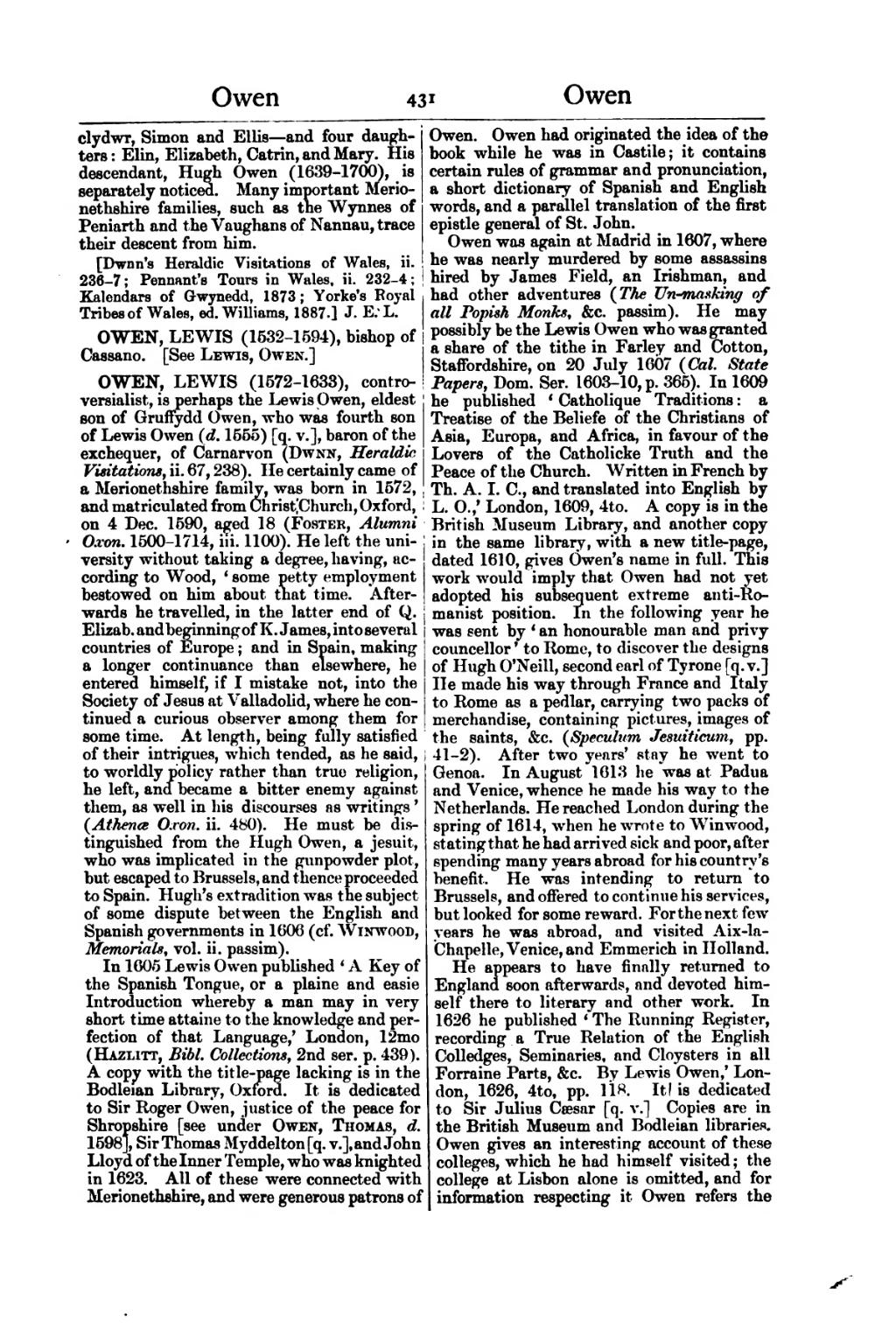clydwr, Simon and Ellis—and four daughters: Elin, Elizabeth, Catrin, and Mary. His descendant, Hugh Owen (1639–1700) [q. v.], is separately noticed. Many important Merionethshire families, such as the Wynnes of Peniarth and the Vaughans of Nannau, trace their descent from him.
[Dwnn's Heraldic Visitations of Wales, ii. 236–7; Pennant's Tours in Wales, ii. 232–4; Kalendars of Gwynedd, 1873; Yorke's Royal Tribes of Wales, ed. Williams, 1887.]
OWEN, LEWIS (1532–1594), bishop of Cassano. [See Lewis, Owen.]
OWEN, LEWIS (1572–1633), controversialist, is perhaps the Lewis Owen, eldest son of Gruffydd Owen, who was fourth son of Lewis Owen (d. 1555) [q. v.], baron of the exchequer, of Carnarvon (Dwnn, Heraldic Visitations, ii. 67, 238). He certainly came of a Merionethshire family, was born in 1572, and matriculated from Christ Church, Oxford, on 4 Dec. 1590, aged 18 (Foster, Alumni Oxon. 1500–1714, iii. 1100). He left the university without taking a degree, having, according to Wood, ‘some petty employment bestowed on him about that time. Afterwards he travelled, in the latter end of Q. Elizab. and beginning of K. James, into several countries of Europe; and in Spain, making a longer continuance than elsewhere, he entered himself, if I mistake not, into the Society of Jesus at Valladolid, where he continued a curious observer among them for some time. At length, being fully satisfied of their intrigues, which tended, as he said, to worldly policy rather than true religion, he left, and became a bitter enemy against them, as well in his discourses as writings’ (Athenæ Oxon. ii. 480). He must be distinguished from the Hugh Owen, a jesuit, who was implicated in the gunpowder plot, but escaped to Brussels, and thence proceeded to Spain. Hugh's extradition was the subject of some dispute between the English and Spanish governments in 1606 (cf. Winwood, Memorials, vol. ii. passim).
In 1605 Lewis Owen published ‘A Key of the Spanish Tongue, or a plaine and easie Introduction whereby a man may in very short time attaine to the knowledge and perfection of that Language,’ London, 12mo (Hazlitt, Bibl. Collections, 2nd ser. p. 439). A copy with the title-page lacking is in the Bodleian Library, Oxford. It is dedicated to Sir Roger Owen, justice of the peace for Shropshire [see under Owen, Thomas, d. 1598], Sir Thomas Myddelton [q. v.], and John Lloyd of the Inner Temple, who was knighted in 1623. All of these were connected with Merionethshire, and were generous patrons of Owen. Owen had originated the idea of the book while he was in Castile; it contains certain rules of grammar and pronunciation, a short dictionary of Spanish and English words, and a parallel translation of the first epistle general of St. John.
Owen was again at Madrid in 1607, where he was nearly murdered by some assassins hired by James Field, an Irishman, and had other adventures (The Un-masking of all Popish Monks, &c. passim). He may possibly be the Lewis Owen who was granted a share of the tithe in Farley and Cotton, Staffordshire, on 20 July 1607 (Cal. State Papers, Dom. Ser. 1603–10, p. 365). In 1609 he published ‘Catholique Traditions: a Treatise of the Beliefe of the Christians of Asia, Europa, and Africa, in favour of the Lovers of the Catholicke Truth and the Peace of the Church. Written in French by Th. A. I. C., and translated into English by L. O.,’ London, 1609, 4to. A copy is in the British Museum Library, and another copy in the same library, with a new title-page, dated 1610, gives Owen's name in full. This work would imply that Owen had not yet adopted his subsequent extreme anti-Romanist position. In the following year he was sent by ‘an honourable man and privy councellor’ to Rome, to discover the designs of Hugh O'Neill, second earl of Tyrone [q. v.] He made his way through France and Italy to Rome as a pedlar, carrying two packs of merchandise, containing pictures, images of the saints, &c. (Speculum Jesuiticum, pp. 41–2). After two years' stay he went to Genoa. In August 1613 he was at Padua and Venice, whence he made his way to the Netherlands. He reached London during the spring of 1614, when he wrote to Winwood, stating that he had arrived sick and poor, after spending many years abroad for his country's benefit. He was intending to return to Brussels, and offered to continue his services, but looked for some reward. For the next few years he was abroad, and visited Aix-la-Chapelle, Venice, and Emmerich in Holland.
He appears to have finally returned to England soon afterwards, and devoted himself there to literary and other work. In 1626 he published ‘The Running Register, recording a True Relation of the English Colledges, Seminaries, and Cloysters in all Forraine Parts, &c. By Lewis Owen,’ London, 1626, 4to, pp. 118. It is dedicated to Sir Julius Cæsar [q. v.] Copies are in the British Museum and Bodleian libraries. Owen gives an interesting account of these colleges, which he had himself visited; the college at Lisbon alone is omitted, and for information respecting it Owen refers the
